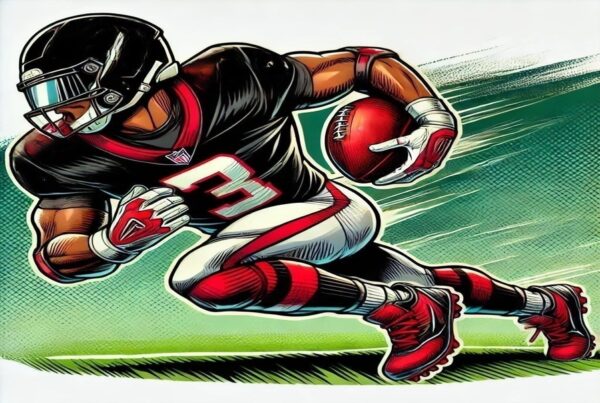Every year, I enter my fantasy football drafts with a sense of dread when it comes to selecting a tight end. Should you even bother drafting a tight end in the top seven rounds of your fantasy football league? We did the research to answer that question for you. Let’s dive into the numbers and find out if investing in a tight end early is worth it, or if you should focus on other positions and grab a tight end later in the draft.
Reviewing Last Year’s Tight Ends
To understand the value of tight ends, I looked at the top 13 tight ends drafted last year in Underdog leagues. These leagues provide a good indication of a player’s success relative to their draft position. All of these tight ends had an ADP (Average Draft Position) above 140, meaning they were taken in the top 12 rounds.
When we averaged the playoff rates for these 13 tight ends, we found that the average playoff rate was 16.8%. This is just slightly above the average playoff rate of 16% (since two out of twelve teams in each league make the playoffs). This indicates that drafting a top 13 tight end had almost no impact on your chances of making the playoffs.
Top Performers from Last Year
Some tight ends did exceed expectations. For example:
- Sam LaPorta: His ADP was very low, but he ended up being the top tight end last year, which greatly helped teams that drafted him. His low cost relative to his production made him a significant value pick.
- Jake Ferguson: Another great value pick who provided strong production at a low cost.
- George Kittle: He was drafted higher but still offered a good playoff advance rate of 26%, making him a valuable addition to fantasy teams.
Analysis of High-Advance Rate Tight Ends
We identified tight ends with a playoff advance rate above the average of 16%:
- George Kittle: Kittle has been one of the most consistent tight ends over the past five years, finishing as a top-five tight end in five of the last six years. His ADP last year was 60.9, and he’s going even lower this year.
- T.J. Hockenson: Hockenson was another tight end who provided significant value. Despite concerns about Jordan Addison taking targets away from him, he maintained a strong playoff advance rate of 21.5%.
- Evan Engram: Engram had a playoff advance rate of 20.6%, benefitting from being the top receiving option for the Jacksonville Jaguars.
Should You Draft a Tight End Early?
We found that there is almost no advantage to drafting a tight end before round seven compared to drafting one after round seven. Here are the playoff advance rates based on when you draft your tight end:
- Before Round 7: The average playoff advance rate was around 16.8%.
- After Round 7: The average playoff advance rate was similar, around 17.7%.
This suggests that you can find tight ends with good value even if you wait until after the seventh round to draft one.
Potential Tight End Picks for This Year
Based on historical data and current ADPs, here are some tight end options to consider for your drafts this year:
Top 100 ADP Tight Ends
- Dalton Kincaid (ADP 52): Kincaid is expected to be a key target for Josh Allen and could produce like a wide receiver at the tight end position. He has the potential to be a league winner.
- Kyle Pitts (ADP 60.9): Pitts has a huge quarterback upgrade and a new offensive system. His talent and situation make him a strong candidate for a high playoff advance rate.
After Round 7 Tight Ends
- T.J. Hockenson (ADP 148): Despite injury concerns, Hockenson has significant upside when healthy. At this ADP, he is a valuable dart throw.
- Ben Sinnott (ADP 174): As a rookie, Sinnott is in a good situation and could be a productive player in his first year.
- Cade Otton (ADP 200): Otton is the tight end one in Tampa Bay and could see a lot of targets in a revamped offense.
- Noah Fant (ADP 176): With a new offensive system in Seattle, Fant could emerge as a key player.
- Jelani Woods (ADP 204): Woods is the tight end one in Indianapolis and has a clear path to significant playing time.
- Kobe Parkinson (ADP 212): Parkinson was paid starter money in LA and could take over as the primary tight end.
Tight Ends to Avoid at Current ADP
While some tight ends are great value picks, others may not provide the same return on investment due to their high ADPs:
- Sam LaPorta: His ADP has risen significantly, making it unlikely that he will provide the same value as last year.
- Trey McBride: Like LaPorta, McBride’s ADP has increased, reducing his potential return.
- Mark Andrews: Andrews has been drafted high based on his 2021 performance, but injuries and a changing offense make him a riskier pick.
- Jake Ferguson: Ferguson’s ADP has also increased, meaning he may not provide the same value as last year.
Conclusion
The data suggests that drafting a tight end early does not provide a significant advantage over waiting until after the seventh round. There are many valuable tight end options available later in the draft that can help you build a strong fantasy football team.
When preparing for your fantasy football draft, consider using tools like the fantasy football draft board and the Commish Kit to help you plan your strategy. These resources provide up-to-date information, optimal players to draft in each round, and strategies to help you win your league.
Remember, the key to success in fantasy football is to stay informed, think strategically, and be willing to take calculated risks on players who can provide high returns. Good luck with your drafts, and here’s to a successful fantasy football season!
For all your fantasy football draft needs, check out Commish Kit. They offer a variety of draft board options, including poster kits, corrugated kits, and their new, improved digital draft board to elevate your draft experience.





